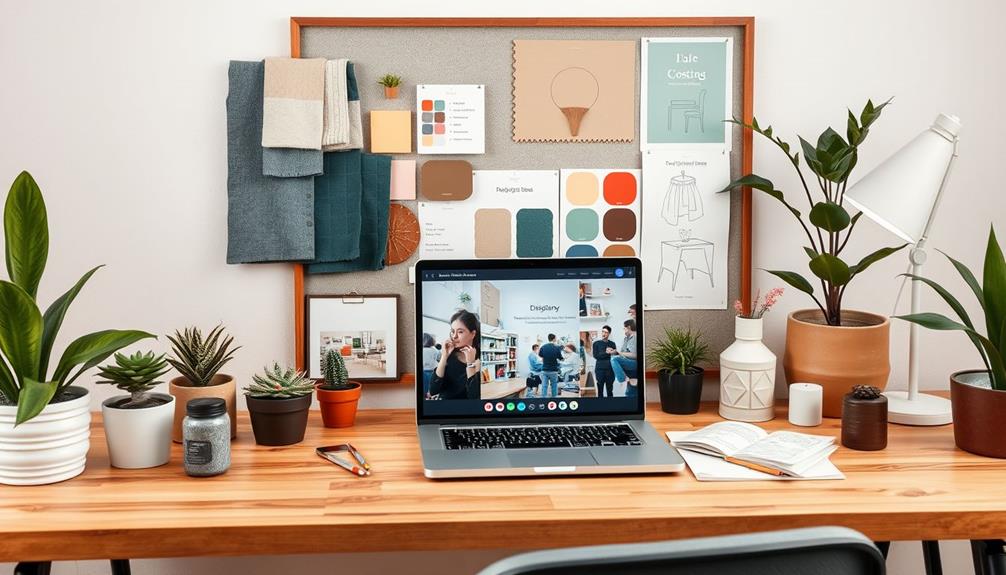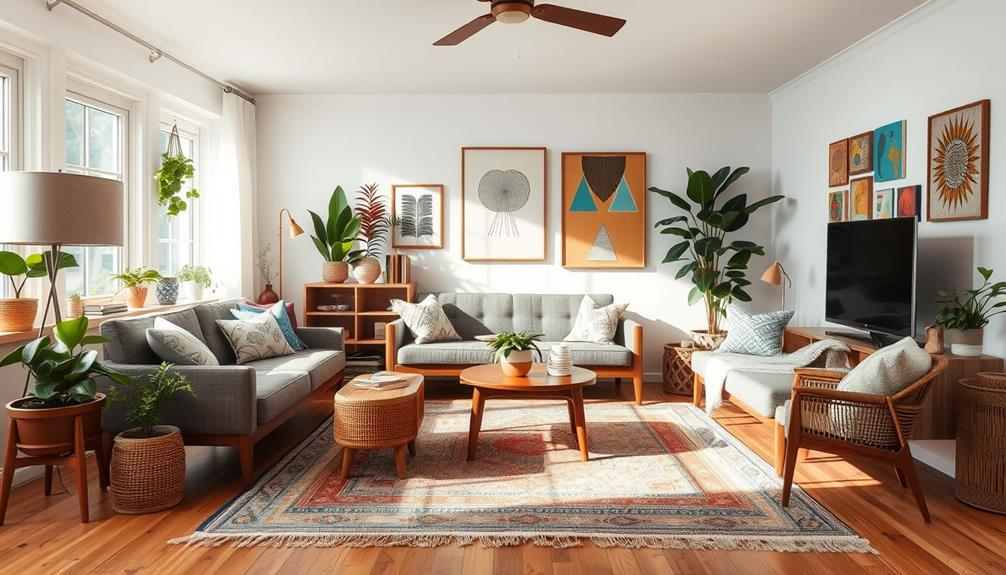You can break into interior design without a degree by focusing on three key areas: creativity, practical experience, and networking. Start by honing your design skills through online courses and self-study. Gain hands-on experience through internships, volunteering, or assisting friends with their projects. Build a strong portfolio showcasing your unique style to attract potential clients. Networking is essential, so join local design groups, attend expos, and engage on social media to connect with professionals. Stay committed to continuous learning and adapt to industry trends. If you're interested in more strategies to succeed, there's plenty more to explore. By building a strong presence online and showcasing your work on platforms like Instagram and Pinterest, you can also focus on attracting leads for interior design. Utilize these platforms to share your projects, connect with potential clients, and demonstrate your expertise in the industry. Additionally, consider partnering with local businesses or home improvement stores to gain exposure and attract potential clients in your area. With a combination of creativity, practical experience, and networking, you can successfully break into the interior design industry without a degree.
Key Takeaways
- Gain practical experience through internships or volunteering on design projects to build skills and confidence.
- Develop a strong portfolio showcasing your unique style using real-world projects and high-quality documentation.
- Network by joining local design groups, attending industry events, and utilizing social media to connect with professionals.
- Self-educate through online courses, design books, and tutorials to acquire essential skills and stay updated on industry trends.
- Set long-term goals to guide your career path and identify necessary skills while seeking mentorship from experienced designers.
Understanding Interior Design Roles
Interior design isn't just about making spaces look good; it involves a deep understanding of how to create functional environments that meet specific needs. As you explore an interior design career, you'll find that the role goes beyond aesthetics.
Successful interior designers must consider essential elements like lighting, color, and layout while ensuring compliance with building codes and structural integrity.
You'll be responsible for crafting detailed design plans and sketches, as well as project bids, all while coordinating with various contractors and specialists, such as electricians and painters. This requires a solid foundation in project management skills to oversee timelines and budgets effectively.
While formal education can certainly enhance your knowledge, many designers thrive through hands-on experience, internships, and self-study. This makes the field accessible even if you don't have a degree.
You'll need to cultivate specific skills required for the job, including creativity, problem-solving, and communication. By understanding these roles and responsibilities, you can better position yourself for success in the interior design industry, whether you choose to work for a firm or operate independently.
Essential Skills for Designers

Designers thrive on creativity, which serves as the cornerstone of their work. To excel in interior design, you need a mix of essential interior design skills that blend both technical and soft skills.
First, hone your creativity to develop unique design solutions tailored to your clients' needs. Understanding client preferences can be enhanced through a solid foundation in key factors for homeowner satisfaction when choosing services.
Next, focus on technical skills, particularly proficiency in design software like CAD and 3D modeling tools. These tools enable you to create detailed floor plans and visual presentations that effectively communicate your design concepts.
Strong communication skills are also essential. You'll engage with clients, suppliers, and contractors, guaranteeing your design visions are accurately translated and executed. This is where your soft skills come into play, as active listening and clear articulation will build strong relationships.
Additionally, organizational skills are fundamental for managing multiple projects, timelines, and budgets. You'll need to keep everything on track and meet client expectations.
Gaining Practical Experience
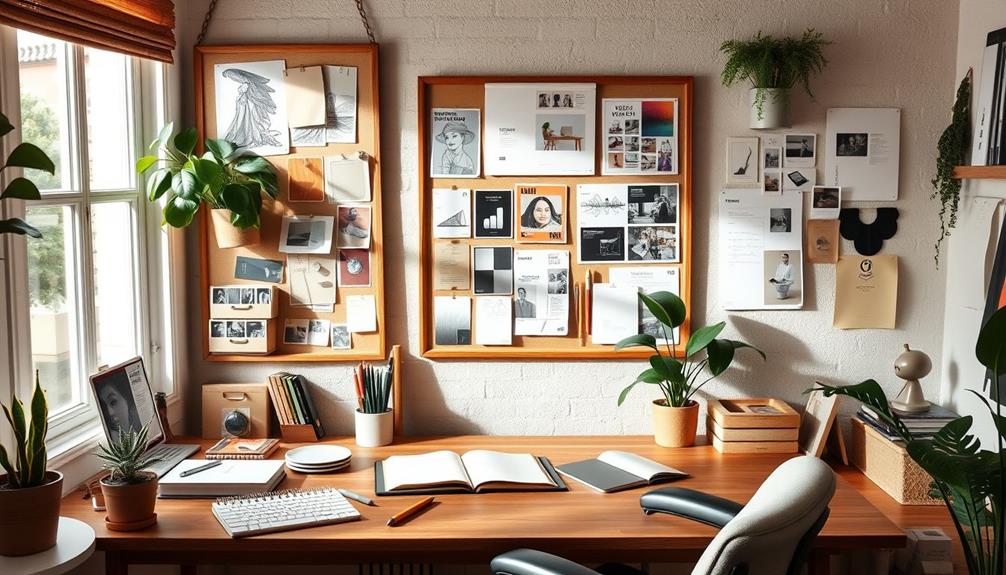
Building on your foundational skills, gaining practical experience is essential for your growth in the interior design field. Start by seeking internships or entry-level positions at interior design firms. This hands-on experience allows you to learn from experienced professionals and understand industry practices. Volunteering for local design projects or nonprofits can also enhance your skills while giving back to the community.
Here's a quick overview of practical experience opportunities:
| Opportunity | Benefits | How to Start |
|---|---|---|
| Internships | Hands-on experience, mentorship | Research local firms, apply online |
| Volunteering | Skill-building, community impact | Contact nonprofits, offer your help |
| Assisting Friends/Family | Real-world practice, feedback | Offer help with their design needs |
| Shadowing Designers | Observational learning, insight | Reach out to designers in your area |
| Competitions | Exposure, creativity showcase | Enter local design contests |
Building Your Portfolio

Creating a strong portfolio is essential for showcasing your unique style and skills in the interior design field. Start building your portfolio by volunteering for design projects, as these experiences provide real-world examples of your interior design work.
You can also consider focusing on specific themes, such as modern farmhouse aesthetics, to create a cohesive look in your portfolio. Include a mix of completed projects, personal design experiments, and any freelance work to demonstrate your range and creativity.
Document each project with high-quality photographs, before-and-after comparisons, and design sketches. This not only illustrates your design process but also highlights the impact of your work.
When it comes to presenting your portfolio, make use of digital platforms like Behance or create a personal website. This makes it accessible to potential clients and employers, allowing them to easily explore your work.
Remember to regularly update your portfolio with new projects and skills you've learned. A dynamic portfolio reflects your growth and adaptability in the field, making you more appealing to potential clients.
Networking Opportunities

Networking opportunities play an essential role in advancing your interior design career, especially without a formal degree. Connecting with other professionals can open doors to mentorship, collaboration, and job leads. Here are some effective ways to network:
| Networking Approach | Benefits | Platforms/Associations |
|---|---|---|
| Join Local Design Groups | Access to networking events and resources | ASID, IIDA |
| Attend Industry Expos | Meet potential mentors and clients | Trade shows, design expos |
| Utilize Social Media | Showcase your work and engage in discussions | LinkedIn, Instagram |
| Volunteer for Projects | Gain experience and expand your network | Community design projects, non-profits |
Participating in networking events organized by local design associations lets you meet industry leaders and fellow designers. Social media platforms provide an excellent avenue for showcasing your designs and connecting with established professionals. Additionally, engaging in community design projects not only enhances your skills but also broadens your network. By leveraging these opportunities, you can build valuable connections that help you thrive in the competitive world of interior design.
Self-Education and Online Learning

Diving into interior design without a formal degree is entirely possible with the right self-education and online learning resources. You can enhance your foundational knowledge through various platforms like Coursera and Udemy, which offer online courses covering essential topics such as interior design principles, color theory, and space planning.
Additionally, exploring healthy lifestyle blogs can inspire creativity and provide fresh perspectives that can be applied to design.
Here are some effective self-education strategies:
- Read design books and magazines: Stay informed about current trends and best practices.
- Explore free YouTube tutorials: Learn design software like SketchUp or AutoCAD, vital for creating floor plans and 3D models.
- Attend webinars and online seminars: Gain insights from experienced professionals and stay updated with industry developments.
Additionally, consider obtaining certifications from recognized organizations, such as the National Kitchen and Bath Association (NKBA). These credentials can boost your credibility and showcase your commitment to professional growth.
Creative Exploration Techniques
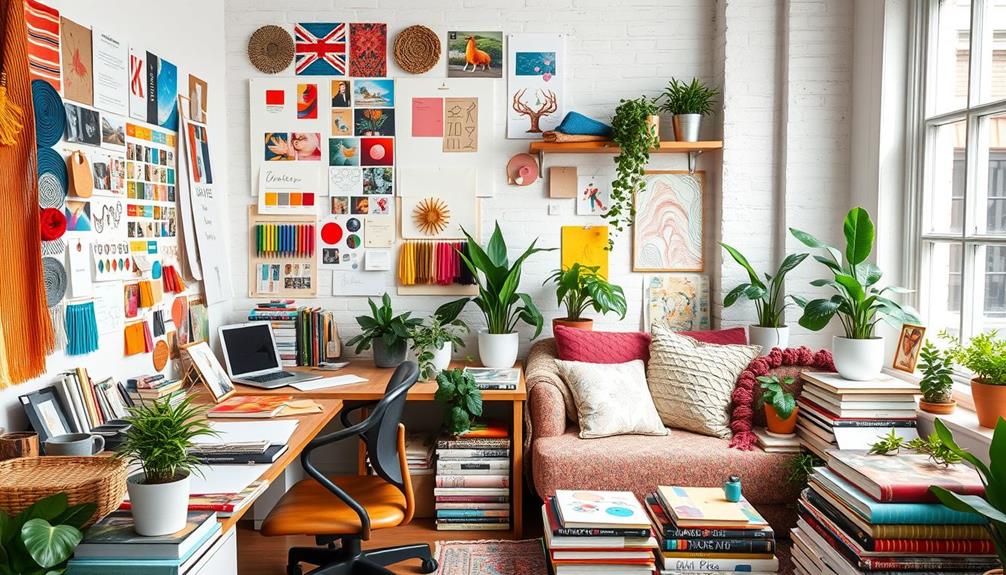
To foster creativity in your interior design journey, exploring unconventional techniques can open up new avenues of inspiration. Start by keeping a travel diary that focuses on design elements like color, texture, and light. This practice can stimulate creative thinking and lead to unique design solutions.
Don't hesitate to shake up your daily routine—exposing yourself to diverse cultures can greatly boost your creativity and design sensibility.
Engaging in creative exploration means experimenting with different materials and layouts. This hands-on approach not only enhances your problem-solving skills but also fosters innovation in your designs.
Participating in workshops or classes at local hardware stores can help you master practical skills while discovering new interior design tools and techniques.
Listening to design podcasts and reading books on creativity can also provide valuable insights. These resources will inspire you and cultivate a more innovative approach to your projects.
Setting Long-Term Goals
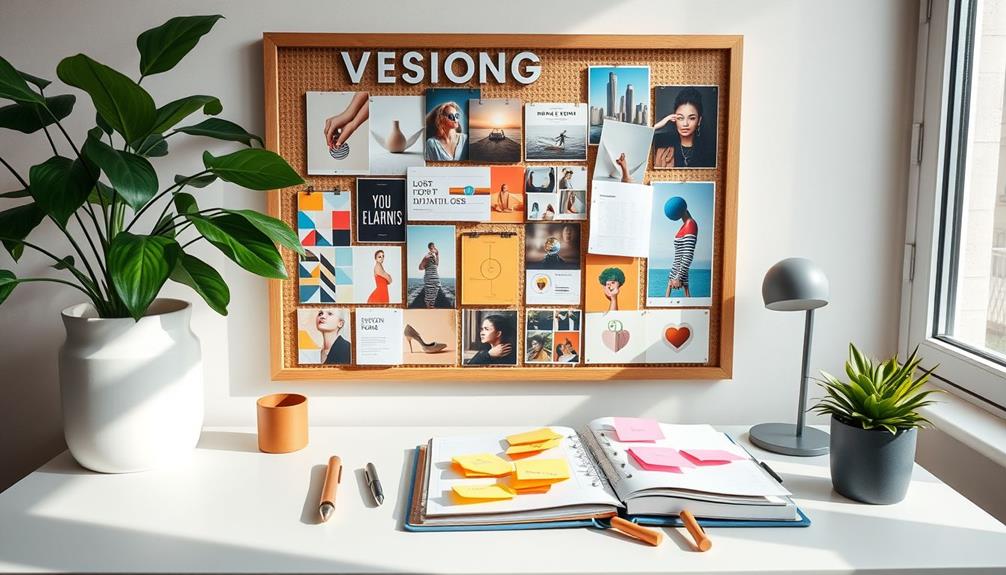
Setting long-term goals acts as a compass in your interior design journey, guiding your decisions and actions toward success. These goals give you direction and motivation, helping you envision where you want to be in the next 2 to 5 years.
Whether it's achieving specific design certifications or building a diverse portfolio, having a clear vision helps you identify the necessary skills and experiences to pursue.
Consider these key aspects when setting your long-term goals:
- Identify milestones: Set achievable targets, like completing internships or apprenticeships, to gain hands-on experience.
- Embrace challenges: View obstacles as opportunities for growth; adapting your strategies will refine your design skills.
- Involve mentors: Seek guidance from experienced professionals; their insights enhance your career in interior design.
Regularly reviewing and adjusting your goals based on industry trends can keep you focused and relevant.
Frequently Asked Questions
Is It Possible to Be an Interior Designer Without a Degree?
Yes, it's absolutely possible to be an interior designer without a degree. Many successful designers rely on hands-on experience, practical skills, and a strong portfolio to showcase their talent and attract clients in the industry.
Can You Be a Self-Taught Interior Designer?
Absolutely, you can be a self-taught interior designer! Immerse yourself in online courses, create a stunning portfolio, and network with industry pros. Your passion and creativity can turn rooms into masterpieces without formal education.
How to Start Out as an Interior Designer?
To start out as an interior designer, seek internships for hands-on experience, build a portfolio with personal projects, attend workshops to sharpen your skills, and network with professionals to explore opportunities and gain insights.
Can You Take the NCIDQ Without a Degree?
You can take the NCIDQ exam without a degree if you've got at least four years of related work experience and education. It's all about putting your best foot forward and gaining that valuable experience!
Conclusion
To summarize, breaking into interior design without a degree is entirely possible with the right approach. Take the example of Sarah, who started redesigning her friends' homes for free, gradually building her portfolio. By networking and showcasing her work on social media, she landed her first paying client within six months. Remember, passion and dedication can take you far in this field, so stay committed to your goals, keep learning, and let your creativity shine!
